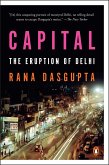In her pioneering book The Global City, Saskia Sassen argued that certain cities in the postindustrial world have become central nodes in the new service economy, strategic sites for the acceleration of capital and information flows as well as spaces of increasing socio-economic polarization. One effect has been that such cities have gained in importance and power relative to nation-states. In this new collection of essays, Sassen and a distinguished group of contributors expand on the author's earlier work in a number of important ways, focusing on two key issues. First, they look at how information flows have bound global cities together in networks, creating a global city web whose constituent cities become global through the networks they participate in. Second, they investigate emerging global cities in the developing world-Sao Paulo, Shanghai, Hong Kong, Mexico City, Beirut, the Dubai-Iran corridor, and Buenos Aires. They show how these globalizing zones are not only replicating many features of the top tier of global cities, but are also generating new socio-economic patterns as well. These new patterns of development promise to lead to significant changes in the structure of the global economy, as more and more cities worldwide are integrated into globalization's circuitry. Includes contributions from:Linda Garcia, Patrice Riemens, Geert Lovink, Peter Taylor, David Smith, Michael Timberlake, Stephen Graham, Sueli Schiffer Ramos, Christoff Parnreiter, Felicity Gu, David Meyer, Pablo Ciccolella, Iliana Mignaqui, Eric Huybrechts, Ali Parsa. Also includes six maps.

Die neue Theorie der Netzwerke
von Albert-László Barabási
Eine neue Wissenschaft von Netzwerken? War dazu nicht längst alles gesagt? Der junge ungarische Physiker Albert-László Barabási behauptet, bisher Unbekanntes entdeckt zu haben: die grundlegende Struktur von Netzwerken, die in einem natürlichen Wachstumsprozess entstanden sind. Und wie es scheint, hat er Recht. Anfang des Jahres erschien in der Zeitschrift Reviews of Modern Physics eine zusammenfassende Darstellung für die Fachwelt; jetzt liegt sein Buch vor, das sich an ein allgemeines Publikum wendet. Es ist eine faszinierende Lektüre: sachlich, präzise, selbstbewusst und brillant. Der wissenschaftliche Aufsatz erlaubt die kritische Überprüfung der Aussagen des Buches. Was sonst vielleicht als spekulativ abgetan würde, ist sorgfältig belegt. Barabási ist auf eine Goldader gestoßen.
In fünfzehn Kapiteln behandelt das Buch drei Themenkomplexe: die empirische Analyse vorgefundener Netzwerke; ihre Erklärung auf der Grundlage eines Entwicklungsmodells; schließlich die Konsequenzen für einen intelligenten Umgang mit Netzwerken aller Art.
Netzwerke sind Systeme aus Knoten und Verbindungen. Deren Natur mag ganz unterschiedlich erscheinen. Im World Wide Web zum Beispiel sind die Knoten Dokumente und die Verbindungen die Links. Für Krankheiten wie Aids sind als Verbindungen die sexuellen Kontakte relevant. Barabási stellt etwa ein Dutzend Beispiele vor. Aus Gründen der Einfachheit wurden in der Vergangenheit entweder ganz regelmäßig oder rein zufällig aufgebaute Netzwerke betrachtet. Die Theorie der letzteren verdanken wir den ungarischen Mathematikern Erdös und Rényi. Barabási knüpft daran an, macht aber deutlich, dass natürliche Netzwerke anders geartet sind.
Seit langem weiß man, dass Netzwerke „kleine Welten” sind: zwischen je zwei Knoten gibt es erstaunlich kurze Verbindungswege. So fand zum Beispiel Milgram 1967, dass zwei beliebige Menschen in den USA durch eine Kette von im Mittel nur sechs Bekanntschaften verbunden sind. Im World Wide Web sind je zwei Dokumente etwa 19 Links voneinander entfernt. Ein anderes Merkmal von Netzen sind ihre „Cliquen”: Gruppen von Knoten, in denen jeder mit jedem verbunden ist. In zufälligen Netzwerken kann man deren Zahl in Abhängigkeit von ihrer Größe leicht berechnen; in natürlichen Netzwerken findet man jedoch eine weit ausgeprägtere Cliquenbildung.
Den Schlüssel zum Verständnis der natürlichen Netzwerke fand Barabási, als er versuchte, die typische Zahl von Verbindungen zu bestimmen, die ein beliebiger Knoten besitzt: die sogenannte „Skala” des Netzwerks. Es stellte sich heraus, dass eine solche Skala nicht existiert. Statt dessen gilt – zunächst nur empirisch begründet – ein einfaches mathematisches Gesetz, wonach es wenige Knoten mit sehr vielen Verbindungen gibt – die „Zentren” – und eine wachsende Zahl von Knoten mit immer weniger Verbindungen. Man nennt dies die Skalenfreiheit natürlicher Netzwerke.
Diese Eigenschaft lässt sich über den Entstehungsprozess erklären: nach und nach kommen neue Knoten hinzu und knüpfen Links vorzugsweise mit bereits vorhandenen Zentren. Beides zusammen – Wachstum und Präferenz für die Zentren – ist essentiell. So ergibt sich, dass natürliche Netzwerke im Allgemeinen robust sind gegenüber Angriffen auf ihre Teile, aber verletzbar durch gezielte Attacken auf ihre wichtigsten Zentren. Umgekehrt darf man wohl schließen, dass ein Netzwerk durch Förderung seiner Zentren am effektivsten gestärkt wird.
Konsequenzen aus diesen Einsichten werden noch zu ziehen sein. Besonders im sozialen und politischen Bereich gibt es ja Netzwerke, die nicht „natürlich” gewachsen sind, sondern nach Plänen eingerichtet wurden. Sind sie deshalb weniger effektiv oder robust? Barabási hat dem Nachdenken über sie eine neue Grundlage gegeben.
PETER RICHTER
ALBERT-LÁSZLÓ BARABÁSI: Linked. The New Science of Networks. Perseus Verlag, Cambridge / Mass. 2002. 280 Seiten. 26 US-Dollar.
SZdigital: Alle Rechte vorbehalten - Süddeutsche Zeitung GmbH, München
Jegliche Veröffentlichung exklusiv über www.diz-muenchen.de
"Saskia Sassen's collection is a unique contribution to the emerging literature on global cities and networks: first, because it assembles state-of-the-art presentations by leading researchers in the field, and second, because it gives due attention to key cities in the developing world, which perform vital roles in the new global networks but have hitherto been neglected. No one interested in this central topic of hte new urban geography can afford to miss this book." -- Sir Peter Hall, Bartlett Professor of Planning at University College London, Director of hte Institute of Community Development, and author of Cities in Civilization
"In Global Networks, Linked Cities, Saskia Sassen extends her path-breaking work on the first tier global cities to focus on the architecture of the networks in which they are embedded. Networking among major cities is generally taken as a key indicator of involvement in globalization, yet few studies examine what those networks actually consist of. This volume plunges into that examination, and the result is a provocative and rewarding foray into the real content of several central concepts in the contemporary discussion of globalization and urban development." -- Peter Marcuse, Professor of Urban Planning, Columbia University and co-editor of Globalizing Cities: A New Urban Spatial Order? and Of States and Cities: The Partitioning of Urban Space
"In Global Networks, Linked Cities, Saskia Sassen extends her path-breaking work on the first tier global cities to focus on the architecture of hte networks in which they are embedded. Networking among major cities is generally taken as a key indicator of involvement in globalization, yet few studies examine what those networks actually consist of. This volume plunges into that examination, and the result is a provocative and rewarding foray into the real content of several central concepts in the contemporary discussion of globalization and urban development." -- Peter Marcuse, Professor of Urban Planning, Columbia University and co-editor of Globalizing Cities: A New Urban Spatial Order? and Of States and Cities: The Partitioning of Urban Space
"Saskia Sassen's collection is a unique contribution to the emerging literature on global cities and networks: first, because it assembles state-of-the-art presentations by leading researchers in the field, and second, because it gives due attention to key cities in the developing world, which perform vital roles in the new global networks but have hitherto been neglected. No one interested in the central topic of the new urban geography can afford to miss this book." -- Sir Peter Hall, Bartlett Professor of Planning at University College London, Director of the Institute of Community Development, and author of Cities in Civilization
"This edited volume contains United Nations U/Institute of Advanced Studies (UNU/IAS) research projects on contemporary global forces underpinnning urban development. The individual essays study the empirical and theoretical specifications on the organizational architecture of an increasing number of transnational cities, particularly cities of the global South that are mid-range on the global hierarchy... Issues specific to Mexico, the Hormuz Corridor, Sao Paulo, Beirut, Hong Kong, Shanghai, Buenos Aires, and Amsterdam are discussed in the twelve chapters." -- Social Change and Economic Development
"...explores the key issue of telematics infrastructure and hints at the important policy question of whether infrastructure must lead clustering of coordination functions or vice versa." -- American Journal of Sociology
"This collection is an important contribution to the literature on global cities... And yet the roles these cities play in the global economy are sufficently varied to show that historical development and local cultures also shape the impact of globalization. While this may not have been the intended message of these essays, for those interested... it is a welcome message indeed." -- H-Net
"Overall this volume provides a wealth of detail on the various interconnections within and between cities in the global hierarchy.
." -- Journal of Planning Education and Research
"In Global Networks, Linked Cities, Saskia Sassen extends her path-breaking work on the first tier global cities to focus on the architecture of the networks in which they are embedded. Networking among major cities is generally taken as a key indicator of involvement in globalization, yet few studies examine what those networks actually consist of. This volume plunges into that examination, and the result is a provocative and rewarding foray into the real content of several central concepts in the contemporary discussion of globalization and urban development." -- Peter Marcuse, Professor of Urban Planning, Columbia University and co-editor of Globalizing Cities: A New Urban Spatial Order? and Of States and Cities: The Partitioning of Urban Space
"In Global Networks, Linked Cities, Saskia Sassen extends her path-breaking work on the first tier global cities to focus on the architecture of hte networks in which they are embedded. Networking among major cities is generally taken as a key indicator of involvement in globalization, yet few studies examine what those networks actually consist of. This volume plunges into that examination, and the result is a provocative and rewarding foray into the real content of several central concepts in the contemporary discussion of globalization and urban development." -- Peter Marcuse, Professor of Urban Planning, Columbia University and co-editor of Globalizing Cities: A New Urban Spatial Order? and Of States and Cities: The Partitioning of Urban Space
"Saskia Sassen's collection is a unique contribution to the emerging literature on global cities and networks: first, because it assembles state-of-the-art presentations by leading researchers in the field, and second, because it gives due attention to key cities in the developing world, which perform vital roles in the new global networks but have hitherto been neglected. No one interested in the central topic of the new urban geography can afford to miss this book." -- Sir Peter Hall, Bartlett Professor of Planning at University College London, Director of the Institute of Community Development, and author of Cities in Civilization
"This edited volume contains United Nations U/Institute of Advanced Studies (UNU/IAS) research projects on contemporary global forces underpinnning urban development. The individual essays study the empirical and theoretical specifications on the organizational architecture of an increasing number of transnational cities, particularly cities of the global South that are mid-range on the global hierarchy... Issues specific to Mexico, the Hormuz Corridor, Sao Paulo, Beirut, Hong Kong, Shanghai, Buenos Aires, and Amsterdam are discussed in the twelve chapters." -- Social Change and Economic Development
"...explores the key issue of telematics infrastructure and hints at the important policy question of whether infrastructure must lead clustering of coordination functions or vice versa." -- American Journal of Sociology
"This collection is an important contribution to the literature on global cities... And yet the roles these cities play in the global economy are sufficently varied to show that historical development and local cultures also shape the impact of globalization. While this may not have been the intended message of these essays, for those interested... it is a welcome message indeed." -- H-Net
"Overall this volume provides a wealth of detail on the various interconnections within and between cities in the global hierarchy.
." -- Journal of Planning Education and Research








